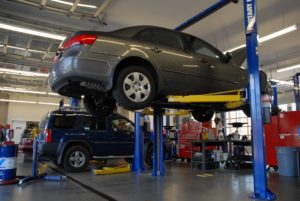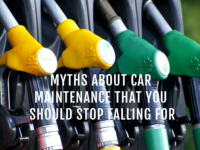There's a lot involved with keeping a car well-maintained, and thus hopefully preventing expensive problems and breakdowns. Performing the recommended maintenance on vehicles should keep systems functioning optimally, conserving gas mileage and prolonging the life of the car. Maintenance done right should actually save money.
However, there are a lot of myths out there about what type of maintenance should be done when, as well as how to care for and drive the vehicle on a daily basis. Unfortunately, much of it ends up being a money waster rather than a money saver.
Here are some of the most common car care fallacies, and why drivers should stop believing them.
- It's best to get the oil changed every 3000 miles. This alone could almost
 double your unneeded car maintenance spending. Check the owner's manual to see exactly what the manufacturer recommends, but most cars will do fine with 5000-7500 miles or more between oil changes. One caveat is that if the car was purchased used and the previous owner's maintenance practices are questionable, damage to the engine could make more frequent oil changes a good idea.
double your unneeded car maintenance spending. Check the owner's manual to see exactly what the manufacturer recommends, but most cars will do fine with 5000-7500 miles or more between oil changes. One caveat is that if the car was purchased used and the previous owner's maintenance practices are questionable, damage to the engine could make more frequent oil changes a good idea. - Filling the car with premium gasoline will help it run better. Premium or high-octane gasoline is generally not necessary, or really even useful, in the average vehicle. It can be helpful in vehicles that run hotter, as it can help prevent pre-ignition problems.
- In the winter, it's best to let the car warm up for a few minutes before driving. Idling likely won't burn up a whole lot of fuel, but if done regularly, it can really add up, not to mention the environmental impact. Actually, the engine will warm up and reach maximum fuel efficiency much more quickly once it's on the road.
- For optimal performance, fill the tires to the tire pressure written on the tire sidewall. The tire makers didn't make the car, so the number written on the sidewall is actually a maximum fill recommendation, not a recommendation based on driveability, braking, and fuel efficiency. To find out the recommended tire pressure from the manufacturer, check the sticker on the driver's side door panel.
- It's best to change the air filters at every oil change. Check the owner's manual for the manufacturer's recommended air filter replacement schedule. Sometimes, instead of paying for new ones, the old air filters can just be cleaned with an air compressor and replaced until it is time to swap them out.
- Instead of just replacing one tire when it is damaged, all four should be replaced at the same time. This can be a very expensive misconception. First of all, tires can often be patched instead of replaced unless the damage is major or there is a hole in the sidewall. If the tire does need replacing, as long as the tires are the same brand, model, and size, it's fine to replace one at a time. Just be sure to have the tires rotated at every oil change.
For all your car maintenance needs, be sure to call All in the Wrist Auto for friendly, honest, and smart service.








